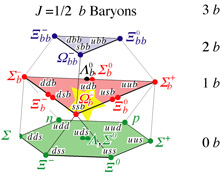 |
A proton, made of two up quarks and a
down quark |
Since Rutherford's scattering experiment with gold and alpha particles (that came from the decay of radium) that proved the atomic nucleus had minute size and a positive charge, we have came a long way in understanding the atom and fundamental particles that make up our universe and ourselves. We now know with reasonable doubt that the atom is made up tiny point-like electrons orbiting a nucleus of protons and neutrons (except the hydrogen atom of course).
 |
One classification of one type of
baryons (particles made of three quarks).
Mesons on the other hand are made
of one quark and one anti-quark.
Courtesy of Fermilab |
Entering the second half of the 20th century, particle physicists discovered a zoo of 'elementary' particles, pions, kaons, J/ψ, and many others. They thought nature would not be so complicated and they sought out a theory to explain the existence of these particles. Similar to the work done on the periodic table of elements, using the proton number to order the elements, Murray Gell-Mann and Yuval Ne'eman independently suggested a theory to explain that all the 'elementary' particles are not so elementary after all. The problem with theory is that although it was able to explain the particle zoo, quarks were never seen before. They were never created and observed in the laboratory.
 |
| SLAC, USA |
Ok, so if we can't create and see them, how are we so sure they exist? Particle physicists have shot protons with high energy electron beams to show that they actually are composite, e.g. made up of quarks. At the Stanford Linear Accelerator (SLAC), they repeated the earlier Rutherford experiment but the target was now a proton and the beam an electron. The results showed that the electron moved in a way that suggested that the proton was not a point particle. At even higher electron energies, they see the electron move (scatter at an angle) even more. This proved, like how Rutherford proved that there was localized structured in the atom, that there were substructure in the proton. We now call them quarks (Feynman called them partons).
Other experiments like HERA in Hamburg, Germany also studied the structure of the proton.
In addition to the two up-quark and one down-quark we say made up the proton, there is a sea of quarks, or rather valence quarks (analogous to the valence electrons orbiting the atom).
 |
Our current picture of the proton. It
consists of quarks, antiquarks and
gluons. |
These pairs of quarks and anti-quarks exist only momentarily; formed from an energetic gluon, they will come back together and annihilate returning once again to a gluon. They probed to the smallest visibility and saw up to 100 of these quark/anti-quark pairs at any instant.
I just used the word 'gluon' without explaining. Basically it is something that gets passed around between quarks when they interact. You do not see them directly too. Strange how particle physics has evolved right?
I'm flying back to Sweden tonight. Looks like I am going to miss the sun and the windless weather in Meyrin for the colder air of Lund. Update: Flight got redirected to Frankfurt before going to Copenhagen. Looks like I get to see some of Germany today.








No comments:
Post a Comment